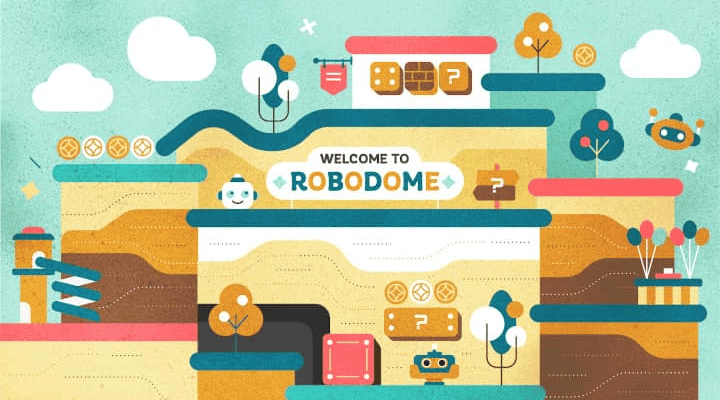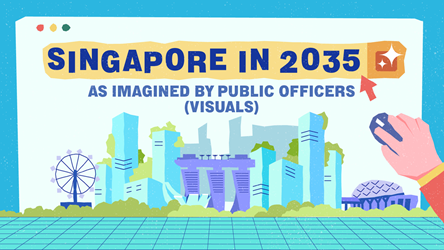How You Learn About the Latest Technological Developments
Public officers share which technological developments intrigue them and how they keep up with and learn more about tech trends.

Winning Entry
The recent technological development is for sure the Metaverse. I think it provides a safe and innovative way for people to virtually interact with one another all around the world. The potential of the Metaverse is immense. It could help provide solutions for tourism, learning and even government services.
For example, any tourist could have a glimpse of Singapore and interact with the city before stepping here physically. That would provide a sense of familiarity and confidence for tourists to visit Singapore. Another example is government services. Members of the public could interact with government agencies for their services without stepping out of their house.
I have been following the news about Metaverse and how the current community is shaping us today, picking up Udemy courses, and looking to get a device to connect to the Metaverse world. I am also preparing to take the Virtual Reality Specialisation on Coursera.
I believe a deeper understanding and hands-on creation of my own VR space can help me to adapt to the fast pace of technological advancement. There are a ton of business ideas and opportunities to solve the real-life problems we have right now.
William Wong, PSD
Thank you for sharing your entry, William! You win $100 worth of Best Denki vouchers so you can gear up to accelerate your learning further.
Other Winning Entries

I've always been fascinated by theme park technology, from the very first Audio-Animatronics (animated electronic characters) in the Enchanted Tiki Room to the latest stuntronics (robotic stunt doubles) at Avenger's Campus. The Omnimover ride system, which allowed ride vehicles to swivel, has evolved into more immersive trackless dark rides. The combination of multiple theme park technologies in recent years has created attractions that are unbelievably life-like.
While details about projects at Universal Studios Singapore (USS) are often kept under wraps, major global projects at prominent Universal and Disney parks often release public patents and blueprints. By keeping up with these documents, I learn all the fascinating new technologies in the industry.
I often read up on all these patents and blueprints, hoping and wondering what might eventually come to USS for Singaporeans to enjoy. While many of these patents don't come to fruition, they inspire future designs.
Transformers: The Ride at USS is an improved version of The Amazing Adventure of Spider-Man. Using their experience with these two rides, Universal recently outdid themselves with Beijing's Jurassic World Adventure. With audio-animatronics rivalling or even beating Disney's life-like A1000s, you would actually believe a dinosaur is chasing you!
Bryan Lye, VITAL
As an educator, I have always been interested in learning more about the latest technologies and incorporating them into my lessons. While technologies for game-based learning have been around for a long time, I only recently discovered how educators from other countries have been creating interactive fiction games using open-source tools like Twine. These games develop students' literacy skills and get them to take on different perspectives through the different choices they make.
This spurred me to create my own game on Twine. I spent a week looking up tutorials, typing out the HTML code and fine-tuning some elements before testing it out for one of my classes. The response was encouraging as the students were able to make links between the fictional game and the History content they were learning. The students were also very engaged and excitedly discussing whether they ended up "dying" or "surviving" in the game.
However, as with any other lesson, there are always areas for improvement. I intend to continue familiarising myself with other elements of Twine and get feedback from other teachers. Hopefully, with the effective use of gamification, students will be more engaged and become more motivated to keep learning.
Aw Yang Jie Ling, MOE (Kranji Secondary School)
Cybersecurity mesh! It is defined by Gartner as "a flexible, composable architecture that integrates widely distributed and disparate security services".
A mesh will use analytics and intelligence coupled with ‘meshed’ controls around identity, policy, posture and information/event visibility. This will improve security by shifting the control points closer to the assets to be protected, and protect against emerging threats in real-time.
I am reading more about this as it gets more pertinent. I believe it could be useful in preventing hackers, which has seen an upward trend in recent times. It would be interesting to read more real-life use cases as implementation widens globally.

To get more stories like this, subscribe to the Challenge Telegram channel.
I've recently started exploring Swift Playground to begin coding in Apple's programming language. With this, I can import layered illustrations created on the iPad, edit them in 3-D and build Augmented Reality scenes.
I'm currently working on experiential change communication ideas and working with different media types to build interest around new systems and process rollouts. Swift Playground opens up new opportunities for interactive experiences, with the potential to spark conversations around important topics and increase employee engagement. Who knew internal communications could be so fun! =D
Ng Yun Ling, NHB
Mine was because of PSD Challenge's article “Learn Something New In 5 Minutes”.
I have tried to learn Python programming on many different platforms, including YouTube, Udemy and Coursera, but have had no success whatsoever. Through your article, I started using Mimo and manage to proceed quite far into the course. I managed to learn more than I had previously.
Thank you for your recommendation! I will continue to look out for the good stuff you folks share!
Gerald Huang, MOE

What work do you dread the most? If you could get rid of it, what would you use the saved time and energy to pursue? (Work-related endeavours only!)
Share your thoughts in about 250 words, and send your entry to psd_challenge@psd.gov.sg
The most thought-provoking or creative entry will receive a prize worth $100.
All other entries published will win vouchers worth $30 each. Entries may be edited. Please include your name, agency email address, agency and contact number.
All entries should reach us by July 15, 2022.
- POSTED ON
May 25, 2022









